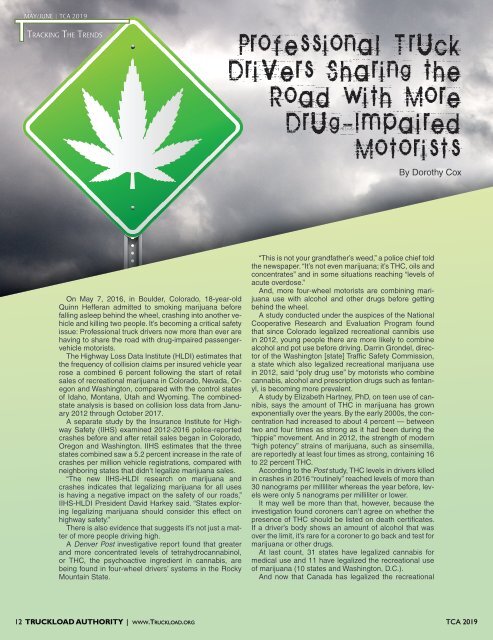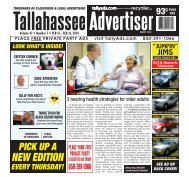Truckload Authority - April/May 2019
Create successful ePaper yourself
Turn your PDF publications into a flip-book with our unique Google optimized e-Paper software.
MAY/JUNE | TCA <strong>2019</strong><br />
Tracking The Trends<br />
By Dorothy Cox<br />
On <strong>May</strong> 7, 2016, in Boulder, Colorado, 18-year-old<br />
Quinn Hefferan admitted to smoking marijuana before<br />
falling asleep behind the wheel, crashing into another vehicle<br />
and killing two people. It’s becoming a critical safety<br />
issue: Professional truck drivers now more than ever are<br />
having to share the road with drug-impaired passengervehicle<br />
motorists.<br />
The Highway Loss Data Institute (HLDI) estimates that<br />
the frequency of collision claims per insured vehicle year<br />
rose a combined 6 percent following the start of retail<br />
sales of recreational marijuana in Colorado, Nevada, Oregon<br />
and Washington, compared with the control states<br />
of Idaho, Montana, Utah and Wyoming. The combinedstate<br />
analysis is based on collision loss data from January<br />
2012 through October 2017.<br />
A separate study by the Insurance Institute for Highway<br />
Safety (IIHS) examined 2012-2016 police-reported<br />
crashes before and after retail sales began in Colorado,<br />
Oregon and Washington. IIHS estimates that the three<br />
states combined saw a 5.2 percent increase in the rate of<br />
crashes per million vehicle registrations, compared with<br />
neighboring states that didn’t legalize marijuana sales.<br />
“The new IIHS-HLDI research on marijuana and<br />
crashes indicates that legalizing marijuana for all uses<br />
is having a negative impact on the safety of our roads,”<br />
IIHS-HLDI President David Harkey said. “States exploring<br />
legalizing marijuana should consider this effect on<br />
highway safety.”<br />
There is also evidence that suggests it’s not just a matter<br />
of more people driving high.<br />
A Denver Post investigative report found that greater<br />
and more concentrated levels of tetrahydrocannabinol,<br />
or THC, the psychoactive ingredient in cannabis, are<br />
being found in four-wheel drivers’ systems in the Rocky<br />
Mountain State.<br />
“This is not your grandfather’s weed,” a police chief told<br />
the newspaper. “It’s not even marijuana; it’s THC, oils and<br />
concentrates” and in some situations reaching “levels of<br />
acute overdose.”<br />
And, more four-wheel motorists are combining marijuana<br />
use with alcohol and other drugs before getting<br />
behind the wheel.<br />
A study conducted under the auspices of the National<br />
Cooperative Research and Evaluation Program found<br />
that since Colorado legalized recreational cannibis use<br />
in 2012, young people there are more likely to combine<br />
alcohol and pot use before driving. Darrin Grondel, director<br />
of the Washington [state] Traffic Safety Commission,<br />
a state which also legalized recreational marijuana use<br />
in 2012, said “poly drug use” by motorists who combine<br />
cannabis, alcohol and prescription drugs such as fentanyl,<br />
is becoming more prevalent.<br />
A study by Elizabeth Hartney, PhD, on teen use of cannibis,<br />
says the amount of THC in marijuana has grown<br />
exponentially over the years. By the early 2000s, the concentration<br />
had increased to about 4 percent — between<br />
two and four times as strong as it had been during the<br />
“hippie” movement. And in 2012, the strength of modern<br />
“high potency” strains of marijuana, such as sinsemilla,<br />
are reportedly at least four times as strong, containing 16<br />
to 22 percent THC.<br />
According to the Post study, THC levels in drivers killed<br />
in crashes in 2016 “routinely” reached levels of more than<br />
30 nanograms per milliliter whereas the year before, levels<br />
were only 5 nanograms per milliliter or lower.<br />
It may well be more than that, however, because the<br />
investigation found coroners can’t agree on whether the<br />
presence of THC should be listed on death certificates.<br />
If a driver’s body shows an amount of alcohol that was<br />
over the limit, it’s rare for a coroner to go back and test for<br />
marijuana or other drugs.<br />
At last count, 31 states have legalized cannabis for<br />
medical use and 11 have legalized the recreational use<br />
of marijuana (10 states and Washington, D.C.).<br />
And now that Canada has legalized the recreational<br />
12 <strong>Truckload</strong> <strong>Authority</strong> | www.<strong>Truckload</strong>.org TCA <strong>2019</strong>

















